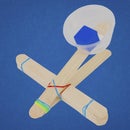Introduction: Rubber Band Helicopters - Engineering Project for Kids
The rubber band-powered helicopter is easy to construct, and with a little practice it can be flown 20+ feet into the air!
You can find the lesson plan, 1-page project sheet, and more project ideas at STEM-Inventions.com
How It Works:
1. Energy is stored in the sport rubber by winding the propeller.
2. When flown, the rubber band rapidly releases its energy by unwinding, which turns both the propeller blade and the paper cutout.
3. The paper cutout pushes against the surrounding air, which creates horizontal air resistance, or drag. This makes it harder for the cutout to spin. Because the cutout does not spin as easily, more energy from the rubber band is released into the propeller, which is much easier to turn. In this way, the paper acts like the rear rotor of a real helicopter
4. As the propeller spins rapidly, it begins to create lift by pushing air downward. With enough energy, the helicopter will fly in whatever direction it is pointing.
Step 1: Materials
All of these materials are used in my other Instructables for kids, so your purchases can be used across multiple projects.
You can find an entire kit of materials here: Rubber Band Helicopter Kit
Or purchase tools and materials individually:
Plastic propellers(smaller pack)
When you make a purchase through these links, I may earn an affiliate commission at zero cost to you.
Step 2: Propeller
The propellers from Kelvin.com should fit snugly onto a craft stick
Step 3: Paperclip
Bending and attaching the paperclip is usually the most challenging step for young kids in grades 1-3. I usually hold the end of the paperclip (on the right side of the photo) between my thumb and forefinger. Then I show how the paperclip bends inside itself. The students need to pull that inside bend apart from the rest of the clip.
Attaching the paperclip can also be tricky. It it's not properly attached, it can be ripped off from too much tension. I try to make it simple for my students: hold the paperclip flat against the craft stick with the tip of the thumb, then tightly wrap a piece of masking tape around it.
It helps if the two ends of the paperclip are separated by the craft stick as shown in the photos, but it's not necessary.
Step 4: Paper Cutout
The paper cutout is crucial; it's what make the copter work. If it's too small, then it won't create enough lateral drag, and too much of the energy in the rubberband will be diverted to the craft stick. If the cutout is huge, it'll simply be too heavy.
I find that cutouts that are about 1.5" by 7" made from cardstock work really well. You can add flavor to this project by create templates for the students to trace, like a helicopter silhouette. For Halloween one year, I made a bat wing template and renamed the project 'Baticopters'
Attach the cutout on the opposite side of the exposed paperclip - this will help ensure that the rubberband won't rub against it.
Step 5: Attach Rubberbands
There are a few ways to attach the rubberbands, but I think the easiest is to put your fingers inside the rubberband and stretch it. The taught rubberband should easily slip into the propeller hook and paperclip.
I find that two rubberbands is the ideal number, but you can experiment.
Step 6: How to Fly
For some students, flying the helicopter is more challenging than building it. First of all, the helicopter must be wound up enough. The number of turns will be different depending upon what brand of rubberband you use. I twist the rubberband until it because completely coiled, and I keep going. You'll notice that the rubberband begins to form a second set of twists that are bulkier - it looks like tight bundles of knotted rubberband. If you fill up the whole length of the rubberband with double-twisted rubberband, then it probably has enough energy.
To fly, hold the top of the propeller and the bottom of the craft stick near the paperclip. For a stable and high-reaching flight, you must let go of the top first and then the bottom within half of a second of each other. This can be difficult for young students to coordinate, so I tell hem to verbally say "tick tock." As they say the words "tick tock," they should respectively let go of the top and bottom of the helicopter.
You can also fly the helicopter sideways following the same procedure.
Step 7: Advanced Ideas
Click on the images for specific design notes.
Step 8: Safety, Tips and Troubleshooting
- Students should pay close attention to their helicopter while winding it. If they're winding it absentmindedly, sometimes their hand will slip away from the propeller, allowing it to spin prematurely. They will naturally move their hand closer to the propeller to continue winding, and the spinning propeller may cut their hand.
- Spinning propellers can get caught in long hair.
- The number one reason helicopters fail to fly is due to simply not winding the rubberband enough.
- The second biggest reason is caused by letting go of the whole helicopter at once. Remind them to say "top-bottom" as they let go. It really helps.
- Cutouts which span less than 3" typically do not perform well.
- With a little practice, students can throw the helicopter as it is being released for additional height
- Stay far away from buildings, trees and fences!
I am always trying to improve my projects, so please let me know what you think. Thanks!

Participated in the
Hands-on Learning Contest

Participated in the
3rd Annual Make It Stick Contest













